Safety? NASCAR drivers, car builders and safety experts may have some tips for Indy-car
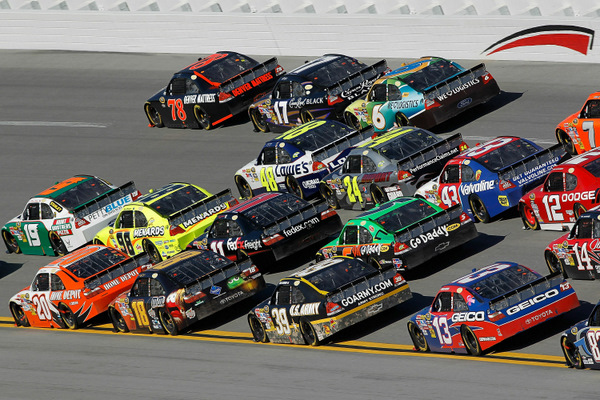
NASCAR drivers, nose to tail at Talladega: but NASCAR stockers are built for the abuse (Photo: Getty Images for NASCAR)
(Updated)
By Mike Mulhern
mikemulhern.net
Then, less than 24 hours after Johnson walked out of the infield hospital at Charlotte, Dan Wheldon was killed in an horrific crash at Las Vegas when his Indy-car got airborne, flew over the soft-wall Safer barrier and became ensnared in catch-fencing.
So while NASCAR's championship playoffs, at the midway point, appear to have boiled down to a three-man chase, with Carl Edwards, Kevin Harvick and Matt Kenseth in command, Johnson and other playing catchup -- though there are still five races left: Talladega, Martinsville, Texas, Phoenix and Homestead -- safety is suddenly back in the fore.
Indy-cars at Las Vegas: and now, after the horrific death of Dan Wheldon? (Photo: IRL)
But then safety is always a prime topic at this track, stock car racing's biggest, fastest oval, Talladega Superspeedway, where drivers race in such tight formations just inches apart, even bump-drafting each other sometimes to gain a bit more speed. The latest craze at this sport's smooth big tracks is the push-draft, where the pusher is running essentially blind.
Breath-taking, yes, for drivers and fans alike.
Fortunately these stockers are quite safe -- how ironic, or perhaps appropriate, that this week's NASCAR stop is famously billed as 'the home of the big one,' as in big, big crashes.
Of course these full-bodied, full roll cage NASCAR stockers are inherently safer than the open-wheeled, and much faster, Indy-cars.
Speed?
Johnson was running maybe 175 mph when he hit the wall; Wheldon, much faster. Charlotte qualifying speeds were 190-plus; Las Vegas, 220-plus. But stockers at Charlotte have to back off the gas in the corners, where Indy-cars at Vegas can run virtually wide open all the way around.
Bobby Allison: the man whose flipping crash at Talladega in 1987 led NASCAR to slap restrictor plates on cars to slow them down (Photo: Getty Images for NASCAR)
And Wheldon's death comes just as the Indy-car series is struggling, sometimes seemingly struggling to survive, or struggling at least to remain relevant.
TV ratings for Indy-car events have been neglible for years. And at Kentucky Speedway just a few weeks ago the Indy-car race drew only about 20,000; at New Hampshire Motor Speedway earlier the Indy-car race drew maybe only 30,000. And promoters at those two tracks just decided last week not to renew Indy-car contracts, because those races weren't financially viable.
On top of that, Danica Patrick, Indy-car's biggest name, is defecting to NASCAR.
And the current Indy-car boss Randy Bernard, two years on the job, had said he would resign if the series finale didn't get good ratings on TV. (ABC carried the race live Sunday; but the crash came less than 20 miles in, and Wheldon's death led abrupt cancelation of the rest of the event.)
Indeed last week there was speculation that the sisters who own and run Indianapolis Motor Speedway – the anchor track for that branch of the sport – were ready to give control back to Tony George, the brother with whom they'd had a falling out.
All that leaves the Indy-car world in turmoil.

Even with the latest safety innovations, NASCAR stockers still can get airborne. Fortunately not very often at all anymore (Photo: Getty Images for NASCAR)
Where Wheldon's death leads this big picture story is not certain.
And where it all leaves NASCAR racing, well, that's not clear either….though a death in major league racing, whichever tour, is a major story in all sport.
Certainly NASCAR's safety record lately looks quite enviable. Johnson in fact just a couple weeks ago said that other sports, like the NHL, might be able to learn something about safety from NASCAR – soft boards, perhaps, he suggested. Football concussions too are a major sports story, that perhaps NASCAR safety initiatives could help address.
But this is Talladega…a place not without its own horror stories over the years.
Without engine carburetor restrictor plates, these stockers might well top 230 mph at this place. Bill Elliott's track record of 212 mph was set more than 20 years ago, without plates, in a quite different era.
Then came Bobby Allison's frightening crash on the frontstretch here in 1987 – no one was killed, and drivers escaped serious injury, though some fans were hit by flying debris as Allison's car ripped down catch-fencing.
And then quickly came the engine carburetor plates, to slow these things down to under 200 mph.
A race car in the grandstands is the worst nightmare, possibly a sport-ending disaster.
In the 10 years since Dale Earnhardt's death at Daytona – actually a surprisingly low-speed, glancing impact, but enough to snap his head forward and essentially break his neck – NASCAR has put driver safety front-and-center.
Well, most of the time.
And not one driver at the national touring level has been killed on the track.
The soft-walls, HANS devices, much better, stronger seats (custom-molded to the body), much better head supports, much better seatbelt safety harnessing, and a much stricter approach to inspections of safety equipment by NASCAR itself have all made this generation of stock car racers virtually bullet-proof. Gasoline fire is a rarity. Safety workers at every track are quick to the scene. Medical operations – track-side and at the nearest trauma center – are top-notch.
Bullet-proof? Knock on wood.
At least that's the way they race.
The Michael McDowell crash at Texas Motor Speedway a few years back is one of the definitive moments in NASCAR safety history – he walked away from a terrible crash that destroyed his car.
And there are many other NASCAR examples.
While NASCAR has resolved many of this sport's most contentious safety issues (and no national touring driver has been killed since Earnhardt), the Indy-car world is now perhaps just beginning to experience its own 'Earnhardt moment.'
The first blame for Wheldon's death was at the track itself: Too many cars, running too fast, on a 1-1/2-mile oval?
Should Indy-car races, like Formula 1, be limited to road courses, where drivers have to slow at times, rather than driving flat out?
However, Indy-car men have been racing at similar ovals for many years. In fact at Texas Motor Speedway Indy-car racers typically put on some of the best racing of the season.
Maybe better catch-fencing might help improve Indy-car safety.
Maybe slower speeds.
Maybe better protection for the open-wheel tires.
Maybe more top-caliber drivers. One big safety plus for NASCAR's Cup series is that there are some 30 to 35 top-caliber drivers in each field; the Indy-car tour far fewer top-caliber drivers…and far fewer races to get know each other's thoughts and moves.
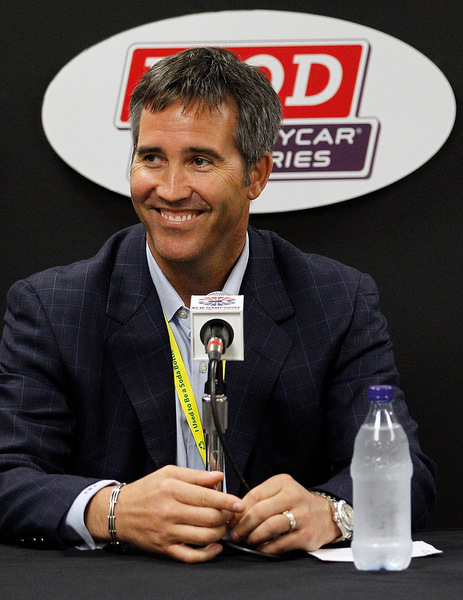
Indy-car boss Randy Bernard (Photo: Getty Images for NASCAR)
While the Indy-car world wrestles with safety now, the big safety issue here is NASCAR's latest rules tweak, designed to promote more passing and less of the two-car stay-hooked-together type of racing seen at Daytona and Talladega this year, on these super-smooth tracks, where the aerodynamic efficiencies of a two-car draft is far superior to that of the old 'big pack.'
Whether the current trend of two-car tandem drafting continues here, after coming to the fore on smoothly resurfaced Daytona back in February in the Sprint Cup tour opener, or if NASCAR's latest rules tweaks for this track will change that dynamic could be clear Thursday during a special round of testing the new fuel injection systems or Friday during practice.
NASCAR racers here race even closer than the Indy-car drivers did at Las Vegas. But Indy-cars are safety-designed in a much different manner than NASCAR stocks. And the sustained high-speeds Indy drivers race at on high-banked ovals, over 220 mph, and the always dangerous open-wheels, which can easily lead to flying cars, are the two basic safety issues that NASCAR itself has dealt with over the past many years.
Yes, Indy-cars race at Indianapolis Motor Speedway, with those long straights and 230 mph speeds. But drivers still have to back off a little for the tight corners. And at Las Vegas, with that 20-degree banking, Indy-car drivers could flat-foot it.
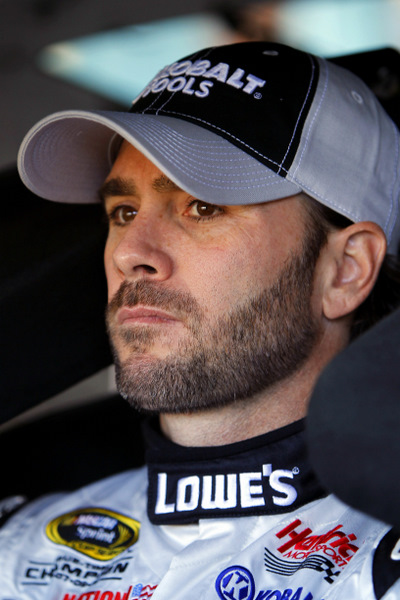
Jimmie Johnson: should Indy-cars not be running on high-banked NASCAR ovals? A. J. Foyt disagrees. (Photo: Getty Images for NASCAR)
Should Indy-cars be essentially barred from racing at high-banked NASCAR ovals?
Las Vegas and Los Angeles' California Auto Club Speedway and Texas are all set for Indy-car races next season, though the full tour calendar hasn't been filled yet.
Jeff Gordon:
"Obviously under the current conditions I wouldn't say that the cars are safe enough to race on those types of high-banked tracks.
"We've seen some really tragic crashes happen on those types of tracks.
"This one -- losing Dan Wheldon -- is one that you'll hopefully make safety something they look at in a different way. Between the owners and the drivers in that series you'll see some big changes coming.
"What those changes will be, I'm not sure.
"But under the current conditions you can't climb a wheel at 200-plus mph and get airborne and not expect there not to be serious consequences.
"It's still unbelievable we lost Dan Wheldon…somebody I met and spent a little time with. Great guy, great driver. He will be sadly missed.
"Hopefully -- like we've seen in NASCAR with tragedies like this -- only positives can come from a safety standpoint.
"The key: keeping the cars on the ground.
"An open-wheel car, at that speed, it's difficult to do."
NASCAR stockers have roof flaps that deploy as air brakes when a car gets turned around.
However Wheldon's car simply got airborne running over the wheels of another car.
Resolving the issue of flying Indy-cars looks to be a hot topic for safety officials to ponder.
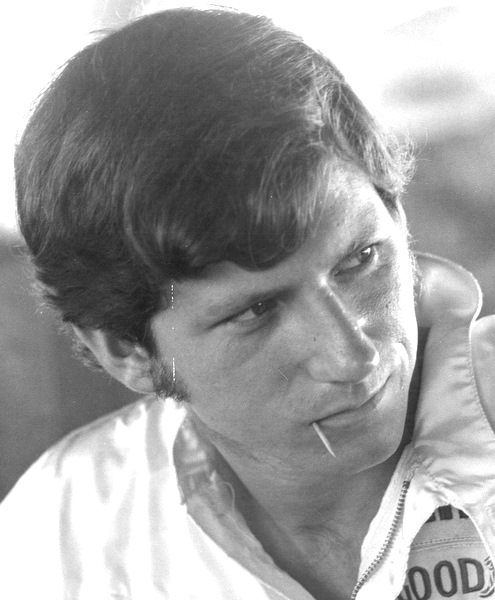
Dale Earnhardt: his death in 2001 sparked NASCAR's many safety improvements (Photo: NASCAR)
And now Talladega…
But Gordon chaffs at any comparison between what can happen here and what happened at Las Vegas: "They're completely different, polar opposites.
"Look at the aerodynamics, the weight of our cars, the full fenders.
"NASCAR has implemented some incredible safety features for our cars over the years to allow us to go to Talladega.
"While drivers might not always be thrilled, and sometimes the fans aren't always thrilled, about the type of racing, I do feel very safe inside the car.
"I feel very confident going to the track this weekend."
Still, NASCAR officials are always cautious, in many ways, when it comes to the issue of safety.
For years drivers would, sometimes angrily, decry the bumper-to-bumper racing at Talladega and Daytona, pointing out that one little mistake could take out 20 cars. There have been fewer such complaints lately (perhaps partly because of the $50,000 penalty NASCAR levied on Ryan Newman last year).
Are these two-car drafts safer than the huge packs? Many drivers seem to prefer the two-car drafts; the fans' verdict, though, is still out. And NASCAR officials seem rather displeased with the two-car drafts…hence the new rules tweaks to try to break them up.
Drivers worry that the new rules will create an even more dangerous situation, by forcing the two drivers in each two-car tandem to swap spots (or risk burning up the motor).
That's because the disparity in speed is dramatic:
Tony Stewart: "When you're in that third group (chasing), and you catch a group that's running side by side, they can't get away from each other, but you're running five to eight mph faster.
"The guy behind you can't tell if you want to slow down, so you have to find a hole when you get there. If you don't find one, you almost have to make one."
Still Stewart says he prefers this two-car thing to the way drivers had to race here in the past:
"You don't see guys blocking like we've seen in the past. I'll be honest -- I didn't like the big packs we used to have to run in. I didn't like that people always had to block.
"Now if you get a run on a guy, you're going to have an opportunity to pass. You may not get it done, but at least you have that opportunity now."
The specifics of the new rules for Talladega:
-- The restrictor plate holes have been increased from 56/64ths of an inch in diameter to 57/67ths. That could add seven to 10 horsepower, which could translate to another two or three mph.
-- The engine radiator pressure is being reduced (with a valve) by about eight psi. That means engines for 'pushers' will heat up faster….and thus NASCAR hopes drivers will be forced to swap spots to cool the engine.
However when making such a swap, drivers in a two-car draft lose from eight to 10 mph.
It is the closing rate that is so worrisome.
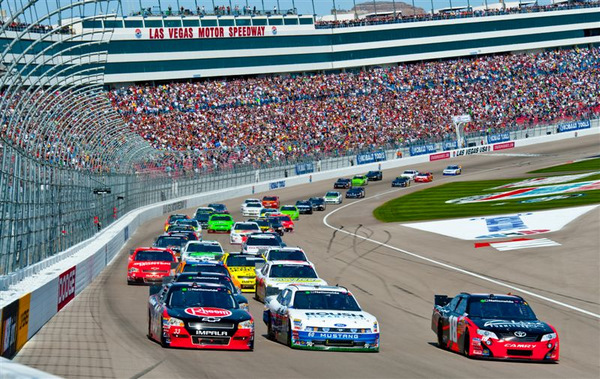
NASCAR at Las Vegas: Soft walls and high fencing. But will the death of Indy-car star Dan Wheldon force costly safety improvements, like high catch fencing? (Photo: Getty Images for NASCAR)
Kyle Busch's take?
Busch -- who has warily made his way through the first half of the playoffs, and only at Charlotte did he show much punch – says NASCAR should give drivers even more horsepower here and at Daytona.
"They should open them (the plates) up more. That small amount they open it up, it's not going to make that big a difference. We're still going to be pushing.
"If you open it up enough to where it really will make a horsepower difference, then we can't push."
One interesting spinoff of the two-car drafts is that, since the trailing driver can't see a thing, the two men are dependent on their spotters for the lay of the land. However, since drivers, once the race starts, don't always have the luxury of picking their drafting partner, they have added as many as a dozen radio channels to various rivals, so they can all talk to each other when paired up.
"You have to work really hard at getting the spotters to communicate," Stewart says. "They're trying to find another spotter that's 20 feet away…"
"It's no fun, (racing) somewhat blind," Gordon says.
As if driving blind at nearly 200 mph weren't wild enough, Gordon says just wait for the final 75 miles of Sunday's Talladega 500:
"No matter what rules are at Talladega, it's going to be a three-wide or four-wide, and hectic, intense, and crazy at the finish.
"But I like the fact that, right now, you don't have these really large packs through the middle part of the race, because that's when a lot of mistakes are made. That's when a lot of accidents -- the big one we always hear about -- happen.
"This two-car draft is actually a little bit safer….and a little less stress."
Unless you happen to be the guy running blind behind someone when the Big One hits….
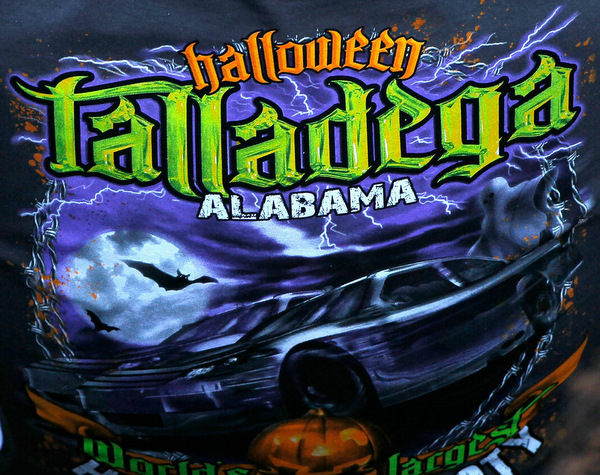
It's always Halloween at Talladega (Photo: Getty Images for NASCAR)
© 2010-2011 www.mikemulhern.net All rights reserved.
Web site by www.webdesigncarolinas.com







I think they can not push on
I think they can not push on the last lap but thats what happens with the
two car tango why ? If nascar enforced that rule it would change a lot of
race ending
NASCAR says the no-push rule
NASCAR says the no-push rule only applies if you are not under power....like outta gas.
It's good to know that the
It's good to know that the stockcar media is so happy with the quality of it's safety at the highest levels. Unfortunatley, at the lower levels of NASCAR (Arca, latemodels, etc) the same can not be said. Since 2000, 16 drivers have died in various types of stockcars mostley at short tracks with slower speeds. In the same time in openwheel, one driver has died in actual competition (Wheldon) while two others died during practice or warmup.
Now NASCAR heeds to Talledega with rule changes to try to get the cars packed back up at 200 miles. While you are right that the drivers at the top level are fairley safe, the same can not be said about the crowd if a car gets back up into the fence like Carl did. NASCAR has done a lot for safety, but they usally were trying to catch up. CART mandated the HANS before NASCAR. NASCAR finally made the change only after four drivers were killed in a years time. The IRL funded and help developed the safer barrier (I know NASCAR like to take credit for coming up with it, but it's was the IRL). Also, CART had there own safety team that traveled to every race with the series that is still the best in the buisness.
Now I know safety has to always be a main concern, but to think that just because you are driving slower or have a roof over your head will save you is mistaken based on the 16 deaths in the last decade. When a car goes thru the fence at Daytona (24 deaths at that track) or Talledega will NASCAR finally say that restrictor plate racing is a dumb idea? It's hard to take advice from a series that promotes "the big one" without feeling like people are pilling on about something they don't know anything about. Maybe NASCAR should be more concerned about the safety at their grassroot short tracks and not so concerned telling other people how to run their series.
Excellent points. I would
Excellent points. I would like to know more about deaths at lower levels of NASCAR racing (NASCAR racing, not other types of racing).....
Some thoughts on this post
Some thoughts on this post -
1 - While Brian is correct about driver deaths at short tracks, citing the slower (overall) speeds ignores proportion - the speeds at those short tracks he mentions I suspect are proportionately faster than what Talladega is presently running; this is manifestly the case with Cup short tracks were unrestricted 130-plus MPH at Richmond produces multiple times higher G-readings than restricted 190 at Talladega - with resultant far harder crashes. This is what I hate the most when discussing the need to restrict the speeds at more Cup tracks - opponents assume 190 is 190 regardless of whether it's at Talladega where drivers gripe that 190 is "slow" or a track like Charlotte that's not designed for 190 for stock cars.
2 - Noting OW's seemingly safer record may be deceptive in that the OW he's mentioning seems to be Indycar (be it CART or IRL). I'm not as well versed on USAC sprint, midget, or Silver Crown racing so I don't know what their safety record is though I do remember brutal tumbles in USAC sprints and midgets back during the ESPN Saturday Night Thunder era.
Indycar has a huge problem in that the controversy is stemming from the wrong issue. Lifting for the corners is not safer than open throttle, and NASCAR stockers are MUCH closer to outright open throttle on intermediates like Charlotte or Vegas than they are to seriously having to lift for the corners. The problem at Vegas was the cars are 220 instead of the 180 Indy Lights run - Indy Lights have put on competitive races and even though they've certainly had airborne crashes their severity is far less than with these 220 MPH cars.
The speed issue is pertinent here - when the cars were "stuck" in the low 190s or even less they were far less likely to get off the ground - if a car goes through the fence it's NOT going to come because of pack racing (Carl Edwards' flip sure as heck didn't come in a pack) but because the speeds are not being restricted enough.
' -- The engine radiator
' -- The engine radiator pressure is being reduced (with a valve) by about eight psi. That means engines for 'pushers' will heat up faster…'
No, the engine will NOT heat up FASTER, the valve will open at a lower pressure which means lower temperature. Or you could say the engines will reach maximum, but lower temperature sooner. But it will not affect the time to get to that temperature.
yes. with lower water
yes. with lower water pressure, the engine will reach its maximum effective racing temperature more quickly, because that temperature is thus lower. therefore nascar hopes drivers will have to swap positions more frequently to cool off their engines.
but me, i'm thinking there's a little more to this than just psi. like teams have been offsetting their bodies in order to get more air to the grill.....
and then there is the distinct safety issue over how much slower the two cars are during any swap, and the closing rate of any trailing tandem....in which of course the pusher is driving blind.
all in all a very intriguing engineering and driving situation. (and i presume you're from the world-famous Tristar engine operation?)
I was curious about
I was curious about something. I understand and support the decision of the NASCAR world to honor Dan Wheldon. However, does anyone remember if the Indy Car world did anything similar to honor Dale Earnhardt during one of their races?
I understand that their season started later that year (they didn't have a race the following week), but the open wheel world has such a low opinion of stock car racing and their fans I was curious about how they reacted when we had a tragedy.
Reply to comment